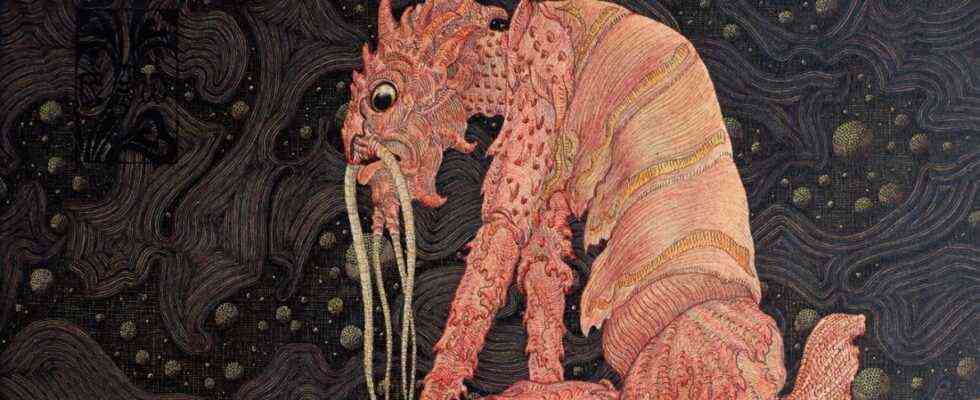Hanns Heinz Ewers was a particularly splendid example of those wandering artist souls who were lit by the torch of extremes before and between the world wars. He experimented with drugs and was enthusiastic about the nudist culture, wrote sex and horror stories as a successful author that allegedly fainted listeners, including the 1911 erotic horror “Mandrake”, which was filmed several times, about a woman who grew out of the seed of a hanged man. Ewers initially felt that he belonged to the avant-garde, cooperated with the anarchist Erich Mühsam, met the occultist Aleister Crowley and traveled the world from Australia to India to South America. But since the First World War he wrote increasingly nationalistically, joined the NSDAP in 1931 and wrote the terrible propaganda novel “Horst Wessel” about the “first martyr of the movement”, only to be dropped again in 1934 by the Nazis.
So why does a story about Ilna Ewers-Wunderwald have to begin with her husband? Because it is so typical of the perception of the bohemian genius culture of those years that artists, with their fickle swing to extremes that satisfy their ego without a moral compass, are honored as interesting revue characters on the cultural stage and are not forgotten, while artists who participate in considered all curiosity and remained humane, have been erased from the annals of cultural history. Like Ilna Ewers-Wunderwald, who fled the extremes of her marriage in 1912 in order to find a harmonious and peaceful way of expression.
In most of her pictures, Ilna Ewers-Wunderwald was looking for something constructive and appealing: “Magnolie” from 1955.
(Photo: Phillip Zwanzig)
In the Horst-Janssen-Museum in Oldenburg, Ilna Ewers-Wunderwald is now erecting a large exhibition monument to rehabilitate the gifted, who a few years ago not even the internet knew about. Then in 2018 there was a first exhibition in the Bröhan Museum, the Berlin State Museum for Art Nouveau, Art Deco and Functionalism, and now the co-editor of Hanns Heinz Ewers’ stories, Sven Brömsel, together with the long-time director of the museum, Jutta Moster-Hoos , retells the story of this extraordinary illustrator, painter, translator, fashion designer and world traveler: as a fate informatively embedded in the historical context of female lawlessness, when “women” were not allowed to study, vote or determine their own money.
She found inspiration in opiates, not destructive energies
Perhaps it is just a confirmation of another cliché that at that time men wanted to provoke with art, whereas women seduced. But if you compare the often drastic language of Hanns Heinz Ewers with the delicate and romantic illustrations of his wife for his books, or his euphoric praise for the consumption of opiates, which the two probably undertook together, with their very controlled color patterns of an “opium” – Leaf, then there are extremely different style consequences from the shared experiences.
Caroline Elisabeth Wunderwald, born in Düsseldorf in 1875, who called herself Ilna and who met her husband at the famous art association “Malkasten”, was truly not a sad child when it came to the excesses of a dandy life. But her splendidly embroidered clothes, her sensitive representations of dreamlike inspirations, and her immersion in nature as the source of Art Nouveau, to which she remained loyal throughout her life, show nothing of the destructive energies with which her famous husband threw himself into these epochs. Apart from a few exceptions, such as gloomy visions of Buddha and Kali after a trip to India together, or the enigmatic portrait of an anthropomorphic aquatic creature on a rock, Wunderwald dedicated itself to the beautiful and illustrative.
Inspired by British artists such as the draftsman Aubrey Beardsley or the social revolutionary artisan William Morris, Wunderwald always looked for something constructive and appealing in their visual and fashion works. On the border between art and handicrafts, the skill of Ilna Ewers-Wunderwald is actually always more inclined to the second, certainly not the vibrating echo of her time, to which the appreciation of pre-war art in large museums is dedicated. On the other hand, this artist has always lived in opposition to the ominous state of war of male competition for which the European slaughterhouse is responsible.
Like so many women of the era, Ilna Ewers-Wunderwald stood in the shadow of her more famous husband Hanns Heinz Ewers. The picture shows her on Capri around 1903.
(Photo: Heinrich Heine Institute, Düsseldorf)
Wunderwald, who translated many French novels with erotic or gruesome content, such as Théophile Gautier’s scandalous novel about the bisexual Mademoiselle de Maupin, with whom she strongly identified, finally fled the urban conflict noise of the German Republic and set out on a world tour on foot in 1930, from which she returned in 1937. She then lived with a partner on Lake Constance until her death in 1957, about whom – like so much in the life of this art-loving adventurer – nothing is known. Perhaps the life of Ilna Ewers-Wunderwald, whose art is too beautiful to be really famous, would be a worthwhile research, biography or novel project. To learn more about the peaceful aspects of an era whose reverberations are shaped by the testimonies of extreme men.
Ilna Ewers-Wunderwald: Expedition Art Nouveau. Horst Janssen Museum, Oldenburg. Until August 29th. The catalog costs 39 euros.

